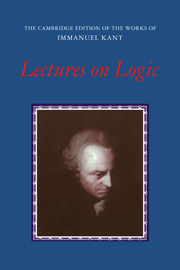Book contents
B - The Hechsel logic (in part)
Published online by Cambridge University Press: 05 June 2012
Summary
[Translator's Note: As noted in the Translator's Introduction, the latter half of the Hechsel Logic appears to have been identical with the latter half of the Vienna Logic. I translate a portion of the Hechsel Logic here to replace what is missing from the Vienna Logic. The translation begins on p. 86 of the Hechsel manuscript, three sentences before the point at which the translation of the Vienna Logic ends.]
… A judgment that does not produce a distinct concept is empty, however. It is not empty of sense, but logically empty. Through them nothing useful is attained because they do not yield a distinct concept, and do not fulfill the understanding's ends. Battology (which has similarity with tautology) is the vain use of many words, where the concept is said with many words, without these many words making the concept distinct. It gets its name from a certain Batto, who observed the opposite of laconism, and who exerted himself to combine many words with few thoughts. Tautology consists in identitas explicita.
We are speaking of mediately and immediately certain judgments. An unprovable judgment that is not capable of further proof is immediately certain. One that it is still possible to prove in speculation is mediate. Proof is mediate certainty of cognition by means of another cognition. That every body is extended no man can prove. This is an elementary proposition of a cognition, from which all other proofs are derived.
- Type
- Chapter
- Information
- Lectures on Logic , pp. 379 - 424Publisher: Cambridge University PressPrint publication year: 1992

